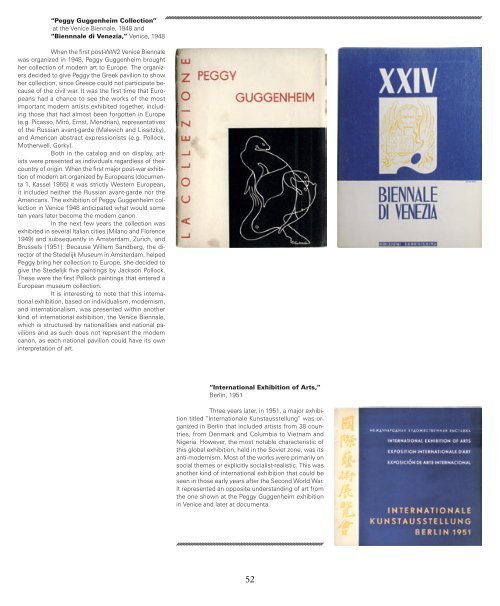Exhibiting Matters
ISBN 978-3-86859-854-4
ISBN 978-3-86859-854-4
Create successful ePaper yourself
Turn your PDF publications into a flip-book with our unique Google optimized e-Paper software.
“Peggy Guggenheim Collection”<br />
at the Venice Biennale, 1948 and<br />
“Biennnale di Venezia,” Venice, 1948<br />
When the first post-WW2 Venice Biennale<br />
was organized in 1948, Peggy Guggenheim brought<br />
her collection of modern art to Europe. The organizers<br />
decided to give Peggy the Greek pavilion to show<br />
her collection, since Greece could not participate because<br />
of the civil war. It was the first time that Europeans<br />
had a chance to see the works of the most<br />
important modern artists exhibited together, including<br />
those that had almost been forgotten in Europe<br />
(e.g. Picasso, Miró, Ernst, Mondrian), representatives<br />
of the Russian avant-garde (Malevich and Lissitzky),<br />
and American abstract expressionists (e.g. Pollock,<br />
Motherwell, Gorky).<br />
Both in the catalog and on display, artists<br />
were presented as individuals regardless of their<br />
country of origin. When the first major post-war exhibition<br />
of modern art organized by Europeans (documenta<br />
1, Kassel 1955) it was strictly Western European,<br />
it included neither the Russian avant-garde nor the<br />
Americans. The exhibition of Peggy Guggenheim collection<br />
in Venice 1948 anticipated what would some<br />
ten years later become the modern canon.<br />
In the next few years the collection was<br />
exhibited in several Italian cities (Milano and Florence<br />
1949) and subsequently in Amsterdam, Zurich, and<br />
Brussels (1951). Because Willem Sandberg, the director<br />
of the Stedelijk Museum in Amsterdam, helped<br />
Peggy bring her collection to Europe, she decided to<br />
give the Stedelijk five paintings by Jackson Pollock.<br />
These were the first Pollock paintings that entered a<br />
European museum collection.<br />
It is interesting to note that this international<br />
exhibition, based on individualism, modernism,<br />
and internationalism, was presented within another<br />
kind of international exhibition, the Venice Biennale,<br />
which is structured by nationalities and national pavilions<br />
and as such does not represent the modern<br />
canon, as each national pavilion could have its own<br />
interpretation of art.<br />
“International Exhibition of Arts,”<br />
Berlin, 1951<br />
Three years later, in 1951, a major exhibition<br />
titled “Internationale Kunstausstellung” was organized<br />
in Berlin that included artists from 38 countries,<br />
from Denmark and Columbia to Vietnam and<br />
Nigeria. However, the most notable characteristic of<br />
this global exhibition, held in the Soviet zone, was its<br />
anti-modernism. Most of the works were primarily on<br />
social themes or explicitly socialist-realistic. This was<br />
another kind of international exhibition that could be<br />
seen in those early years after the Second World War.<br />
It represented an opposite understanding of art from<br />
the one shown at the Peggy Guggenheim exhibition<br />
in Venice and later at documenta.<br />
52


















